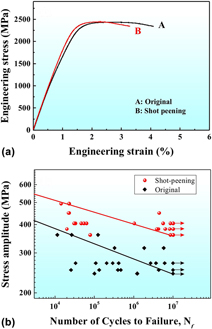Article contents
Improvement of notch fatigue properties of ultra-high CM400 maraging steel through shot peening
Published online by Cambridge University Press: 11 September 2017
Abstract

Shot-peened CM400 maraging steel was used to study the mechanism of enhanced notch fatigue properties of ultra-high strength materials. After shot peening, the specimen surface became rougher, but the transversal machining traces were reduced. The yield strength was slightly improved while the ultimate tensile strength and hardness maintained constant; as a result, the fatigue limit was promoted by about 1.5 times. The nucleated sites of the fatigue fracture were partly changed from the surface to subsurface/interior of the specimen. To further analyze the influencing factors of fatigue properties, the fatigue damage process may be resolved to two aspects: (a) fatigue damage rate affected by shear deformation and (b) fatigue damage tolerance controlled by the dilatation fracture process. Considering the stress state near the notch tip, the hydrostatic stress and maximum shear stress are considered for better understanding these two aspects. It is observed that the fatigue damage tolerance increased while the fatigue damage rate decreased after shot peening. Therefore, the notch fatigue properties of CM400 maraging steels can effectively be improved.
- Type
- Articles
- Information
- Journal of Materials Research , Volume 32 , Issue 23: Focus Issue: Mechanical Properties and Microstructure of Advanced Metallic Alloys—in Honor of Prof. Haël Mughrabi PART A , 14 December 2017 , pp. 4424 - 4432
- Copyright
- Copyright © Materials Research Society 2017
Footnotes
Contributing Editor: Mathias Göken
References
REFERENCES
A correction has been issued for this article:
- 9
- Cited by
Linked content
Please note a has been issued for this article.





